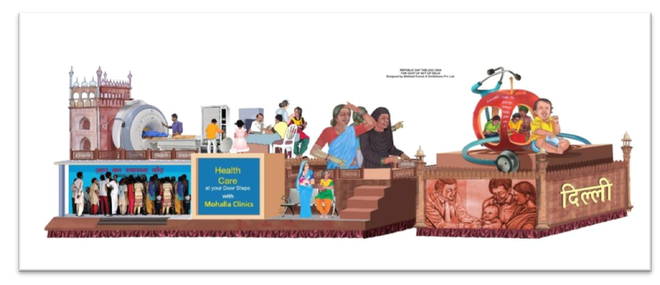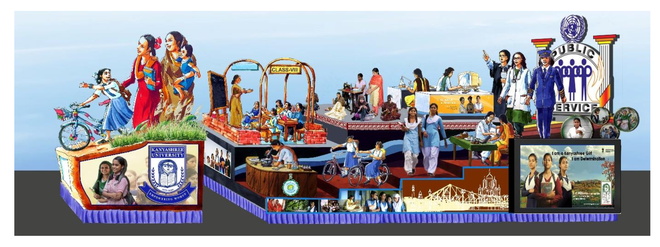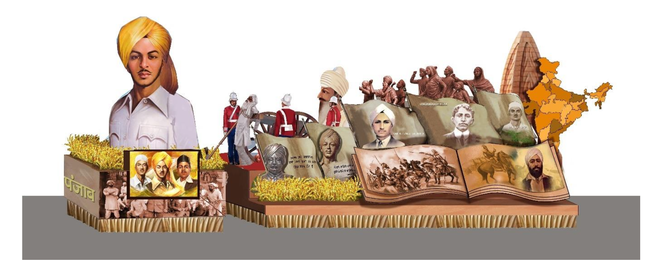The story so far: The latest tussle between the Central government and non-BJP ruled States over the rejection of tableaux proposals for this year’s Republic Day parade has taken a political tone, with the Opposition accusing the Narendra Modi-led government of bias. While the Centre is yet to release the final list of tableaux for the parade, it has rejected the criticism as “baseless” and claimed that the rejected proposals didn’t align with this year’s broader theme.
This is not the first time that such allegations have surfaced in the run-up to the annual parade. “Tableau politics” have made headlines in the past during both National Democratic Alliance (NDA) and the previous United Progressive Alliance (UPA) regimes, with allegations of partisan conduct.
Also Read | On the need for more objectivity in the selection of tableaux for the Republic Day parade
Republic Day parade: how are tableaux selected?
Republic Day is an annual celebration to mark the adoption of the Indian Constitution and India’s transition to a democratic republic. Led by the President from the Kartavya Path in New Delhi, the parade exhibits military might and cultural heritage, which includes tableaux rolled out by States, Union Territories, Central ministries and departments.
The Ministry of Defence (MoD) is responsible for conducting the parade and coordinating arrangements with States and other agencies. Preparations for the ceremony, which has become synonymous with national pride and patriotism, begin months in advance. This process includes the selection and shortlisting of tableaux.
Who makes the selection and on what basis?
As per the Ministry, there is a standard procedure for selecting parade participants. Every year, months ahead of the event, the MoD invites States, UTs and departments to submit sketches or designs for tableaux on a broad theme. For instance, this year’s theme is ‘Viksit Bharat’ (Developed India) and ‘Bharat-Loktantra ki Matruka’ (India-Mother of Democracy).
The sketch or design must be simple, colourful, easy to comprehend and avoid statistical data and unnecessary details. Additionally, the Ministry shares basic guidelines that must be included in the proposal like the use of eco-friendly material and technology. Writing or use of logos on the tableaux is not allowed except for the name of State/UT presenting, which can be in Hindi in the front, English at the back and in the regional language on the sides of the tableau.
The Ministry constitutes a committee of experts from the fields of arts, culture, painting, sculpture, music, architecture, and choreography, among others, to screen proposals. In the first phase, the panel carries out a basic evaluation and suggests modifications in the sketch or design. Once the designs are approved post any modifications, participants present a three-dimensional model of the proposed tableau to the panel. These are examined by experts for final selection. . Only shortlisted candidates are informed about the next round.
The final selection is dependent upon a combination of factors such as visual appeal, impact on the masses, idea or theme of the tableaux, degree of detail, accompanying music, and use of local resources. The selected models are then moved into the custody of the Ministry of Defence, at a “safe location”. The evaluation process typically extends over five to six rounds of meetings.
A State can pitch multiple proposals to the committee, but only one is chosen for the final parade. The Defence Ministry argues that only a limited number of tableaux can be selected due to time constraints and to ensure the participation of the best ones.
However, the exclusion of proposals from Opposition-ruled States has led to accusations of ‘discrimination’ by several State governments.
Politics over rejection of tableaux
This year, tableau proposals by Punjab, Delhi and West Bengal — all non-BJP ruled States — failed to make the final cut. While the Aam Aadmi Party (AAP) is in power in Punjab and Delhi, the Trinamool Congress (TMC) is the ruling party in West Bengal. As per designs uploaded on the MyGov platform, Delhi submitted four sketches, proposing to showcase its mohalla clinics and education services.

West Bengal proposed two designs exhibiting its cultural heritage and the Kanyashree scheme that seeks to improve the status of girls.

Punjab, meanwhile, submitted seven designs for three ideas —the history of the sacrifice of Mai Bhago, the State’s heritage, and the history of the freedom struggle and sacrifices made by freedom fighters.

Controversy erupted last week when Punjab CM Bhagwant Mann remarked that the BJP government had “demeaned” the sacrifices made by Punjabis in the freedom struggle by rejecting the State’s tableau. A war of words followed between the AAP and the BJP after State BJP chief Sunil Jakhar claimed that the CM intended to use the tableau for personal promotion. The Centre dismissed the charges and clarified that Punjab’s proposal didn’t align with the broader theme. In a statement, the MoD said Punjab was shortlisted six times in the last eight years, from 2017 to 2022. The Ministry added a similar clarification on the exclusion of West Bengal, saying the State’s tableau was shortlisted five times in the last eight years.
In 2022, a similar situation played out in the run-up to the parade, when proposals from Tamil Nadu, Kerala and West Bengal were excluded from the final list. The Communist Party of India had termed the Centre’s decision an attack on federalism. The governments of Tamil Nadu and West Bengal later showcased their tableaux during celebrations across the Sates. Last year, Karnataka’s tableau was approved by the Centre following backlash after the then BJP government announced that the State had not made it to the final list — a first in 13 years.
Under the UPA, proposals by the BJP-led Gujarat government were similarly rejected for several years until the saffron party came to power at the Centre in 2014.







